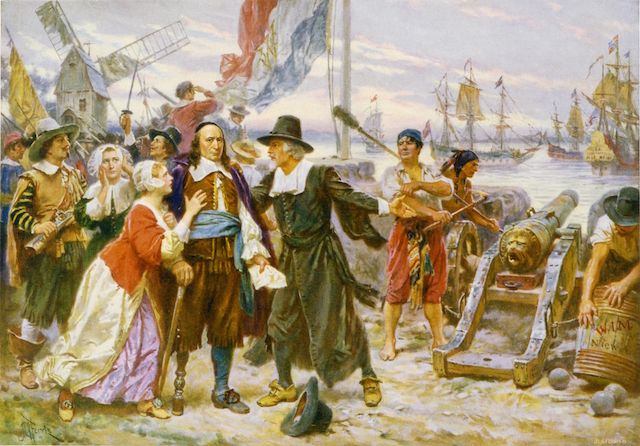Last-Minute NYC Holiday Gift Guide 🎁
We’ve created a holiday gift guide with presents for the intrepid New Yorker that should arrive just in time—


Stuyvesant at the invasion of New Amsterdam by English forces in 1664. Image via Wikimedia Commons
New Amsterdam in the early 1640s was a mess. Trash was strewn about the muddy streets, drunken sailors and farm animals ambled about, and New Netherland’s small population was huddled up in Manhattan after a bruising war against local Native American tribes. Enter Peter Stuyvesant. On May 27, 1647, he took over as Director General of New Netherland for the Dutch West India Company, telling the assembled crowd that he would “govern you as a father his children.” He would play the stern father in New Netherland until 1664, when the Dutch surrendered control of the colony to the British. (New Netherland was the full New York-area colony, New Amsterdam was lower Manhattan.)
Born and raised in the Netherlands, Petrus Stuyvesant spent most of his adult life at sea for the Dutch West India Company in the Caribbean. He worked his way up the ranks, spending two years as Director General of the slave hub island of Curacao. His right leg was taken out by a cannonball in a battle against the Spanish in 1644. A year later, while convalescing in Amsterdam, he was named as William Kieft’s replacement in New Netherland
The Kieft tenure had been a minor disaster thanks to his reckless bellicosity. His slaughter of Lenapes fleeing an invasion from a rival tribe prompted a bloody war (Kieft’s War) that led to the abandonment of Dutch outposts around the tri-state area. Kieft’s War is discussed in a previous Today in NYC History post. Kieft himself drowned when his ship sunk en route to Europe. Stuyvesant arrived to replace him on May 11, 1647, and was inaugurated two weeks later.
People didn’t know what to make us Petrus Stuyvesant, with his battle-hardened face, silver-banded peg leg (earning him the nickname “Old Silver Leg”), and immaculate clothes. From his inaugural address, however, it was clear that he was not going to mess around. A harsh, unpleasant, and intolerant man, Stuyvesant was feared more than loved, especially by his dozens of slaves. But like future New Yorkers from Robert Moses to Rudy, his tough love and lack of charm was deemed necessary to move things forward.
He was intolerant of religion, going so far as to publicly torture a Quaker and banning Quakerism. This act led to the “Flushing Remonstrance” from Queens residents, a document that in some ways presaged the constitution, demanding “love, peace and liberty” for all faiths.
He rejected the constant pleas of New Amsterdamers for increased democracy, setting up sham advisory councils. Complaints against him were sent to the Dutch West India Company, events which led to New Amsterdam’s recognition as a city, though not a diminution in Stuyvesant’s authority. When he imposed new taxes to fund public improvements, many muttered about the “taxation without representation.”
When a farmer killed a Native American woman for stealing a peach, the “Peach War” led to New Amsterdam nearly being overrun, as Stuyvesant had left the city defenseless on a successful but ultimately pointless attack on “New Sweden” in Delaware.
Despite all these shortcomings, Stuyvesant was essential to the growth of the city. Under his leadership the population crossed 1,000 residents. Real infrastructure was developed, including a market, hospital, pier and post office. The sidewalks were paved. Stuyvesant oversaw a new settlement in Bushwick and the growth of villages throughout Brooklyn and Queens. In general, Stuyvesant allowed New Amsterdam to continue as a social and cosmopolitan port town, albeit with some rules.
The end came swiftly. In 1664 the British and Dutch were at war, and New Amsterdam was left isolated, as British forts and warships peppered the Atlantic Coast. Manhattan was surrounded on three sides by water, leaving it vulnerable to a naval attack, and the shaky wall on Wall Street wasn’t going to stop British forces either. When several frigates arrived in the Upper Bay, residents knew the gig was up. Many locals were not even Dutch, and whatever fears the Dutch had were put to rest by a British communication promising that they could keep their property. Stuyvesant was literally the last man who wanted to fight, and he ordered a cannon to prepare to fire on the British ships, an act that could have led to Manhattan being utterly destroyed by British fire. Fortunately, he was stopped by a petition of literally every leading citizen, including one of his sons.
After returning to the Netherlands to give his final report, Stuyvesant retired to his enormous farm (or “bouwerij”, hence the name Bowery), which occupied most of today’s East Village and Gramercy. He died in 1672 and was entombed in St. Marks-in-the-Bowery, where he remains today.
Stuyvesant’s name lives on in New York: Stuyvesant High School, which was founded in 1904; Stuyvesant Town, which sits on his old farm; and BedStuy, which takes the latter half of its name from the old neighborhood of Stuyvesant Heights. Stuyvesant Street is that pretty little diagonal street, leading to the St. Mark’s church, it’s diagonal-ness a condition of the Stuyvesant family allowing the Grid Commission access to the farm.
His most colorful tribute comes courtesy of the Collegiate High School Dutchmen, who honor Stuyvesant as their mascot. Go Dutchmen!
To learn more about New York City political history, follow Janos on Facebook, Twitter or at Janos.nyc.
Subscribe to our newsletter